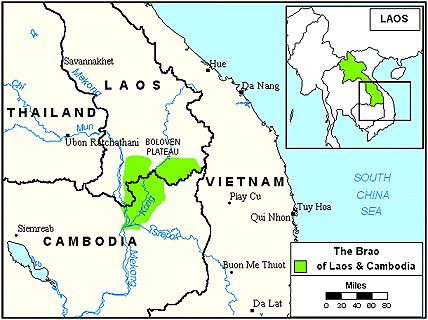|
|
Prayer Profile
The Brao of Laos
![[IMAGE]](../images4/0658.jpg) Approximately 15,000 Brao live in the fertile Boloven Plateau region of southern Laos. At an elevation of approximately 3,500 feet, the plateau was once very productive. However, civil wars, poor transportation, and plant disease have combined to destroy coffee, cotton, and tobacco experiments.
Approximately 15,000 Brao live in the fertile Boloven Plateau region of southern Laos. At an elevation of approximately 3,500 feet, the plateau was once very productive. However, civil wars, poor transportation, and plant disease have combined to destroy coffee, cotton, and tobacco experiments.
The ancestors of the Brao were part of the great Khmer Empire that flourished from the ninth century to the thirteenth century. The empire, which encompassed present-day Laos, Thailand, Cambodia, and parts of Vietnam, declined after the Thai and Vietnamese invasions. The center of the Cambodian Kingdom, known as Angkor, was located in the Boloven region, where there are ruins dating from the eighth to the twelfth centuries.
In recent years, Laos has been the scene of numerous battles and the object of political competition between China, Russia, and Vietnam. Some of the Brao have immigrated into the flatlands of northeastern Thailand.
What are their lives like?
Most of the Brao are rice farmers who use the "slash and burn" method of cultivation. Since much of the area is covered with brush and tall grass, they first clear the plots by burning off the vegetation. Then they grow crops on it for three or four years before moving to new territory. Their principal crop is dry rice, but cassava, sweet potatoes, and bananas are also major products. Fishing provides a reliable source of protein.
In addition to farming, the Brao gather many products from the forest to sell or trade. Vast bamboo groves are spread throughout the area, and the forests contain a variety of hardwoods such as wild date, mahogany, teak, and rosewood, as well as berry, bean, and rubber trees. For additional income, the Brao may also engage in crafts, such as pottery.
Due to internal conflict, the Brao live in large, fortified villages during the dry season. Each village is considered an independent unit and is governed by a village elder or headman. The headman oversees the affairs of the community, judges disputes, and decides important issues. No further lines of political authority are recognized. Although the tribesmen are considered citizens of Laos, most of them have no special representation in the government.
Within the village, the huts are arranged in a circular pattern, with a large community house at the center and the villagers' huts arranged around it like the spokes of a wheel. During times of peace, the large villages split into five to ten smaller villages and occupy makeshift shelters, tilling their fields until the harvest season arrives. Brao society is basically patriarchal (male dominated), and family leadership is directed by the eldest male. Polygyny (having multiple wives) is a common practice.
What are their beliefs?
Although most of the surrounding peoples have adopted Buddhism, virtually all of the Brao continue to practice their traditional ethnic religion. Their practices often include aspects of animism (belief that non-human objects have spirits) and ancestor worship (praying to deceased relatives for guidance and protection). The village priest is responsible for sacrifices made to various spirits of the village. He maintains order in the community so that the spirits are not disturbed.
What are their needs?
The Laotian economy is sustained chiefly through agriculture. The Vietnam War, the disastrous implementation of Marxist economics in 1975-79, and the flight of skilled workers all contributed to making Laos one of Asia's poorest nations. However, great potential exists for the people of the Boloven Plateau if adequate resources for transportation, labor, and technology can be found. Crops could be grown in abundance, aluminum bauxite could be mined, and hydroelectric plants could be built. The Laotian government needs assistance in such massive developments.
The Brao are a war-torn people who need emotional healing and spiritual hope. There are presently three missions agencies working among them; however, few of the Brao have accepted Christ. Additional laborers, evangelistic tools, and increased prayer efforts are needed to effectively reach them with the Good News.
Prayer Points
- Pray that Christian laborers may gain access to the Boloven Plateau to preach the Gospel.
- Ask the Lord to save key leaders among the Brao who will boldly declare the Gospel.
- Pray that missions organizations and churches will accept the challenge of adopting and reaching the Brao.
- Ask God to raise up prayer teams who will begin breaking up the spiritual soil of Laos through worship and intercession.
- Pray that the Jesus film and other Christian materials will soon be produced in the Brao language.
- Ask the Lord to begin revealing Himself to the Brao through dreams and visions.
- Pray that the Brao believers will rise to the challenge of taking the Gospel to their own people.
- Take authority over the spiritual principalities and powers that are keeping the Brao bound.

Statistics
Latest estimates from the World Evangelization Research Center.
THE PEOPLE
- People name: Brao
- Country: Laos
- Their language: Brao
- Population:
- Largest religion:
- Christian: 1%
- Church members: 148
- Scriptures in their own language: Portions
- Jesus Film in their own language: None
- Christian broadcasts in their own language: None
- Mission agencies working among this people: 3
- Persons who have heard the Gospel: 4,000 (27%)
- Persons who have never heard the Gospel: 10,800 (73%)
THEIR COUNTRY
- Country: Laos
- Population:
- Major peoples in size order:
- Major religions:
- Number of denominations: 8
© Copyright 1997
Bethany World Prayer Center
This profile may be copied and distributed without obtaining permission
as long as it is not altered, bound, published
or used for profit purposes.
![[HOME BUTTON]](../graphics/home.jpg)
![[CALENDAR BUTTON]](../graphics/calico.jpg)
![[LIST BUTTON]](../graphics/listico.jpg)
[Home]
[Calendar]
[Country List]
|